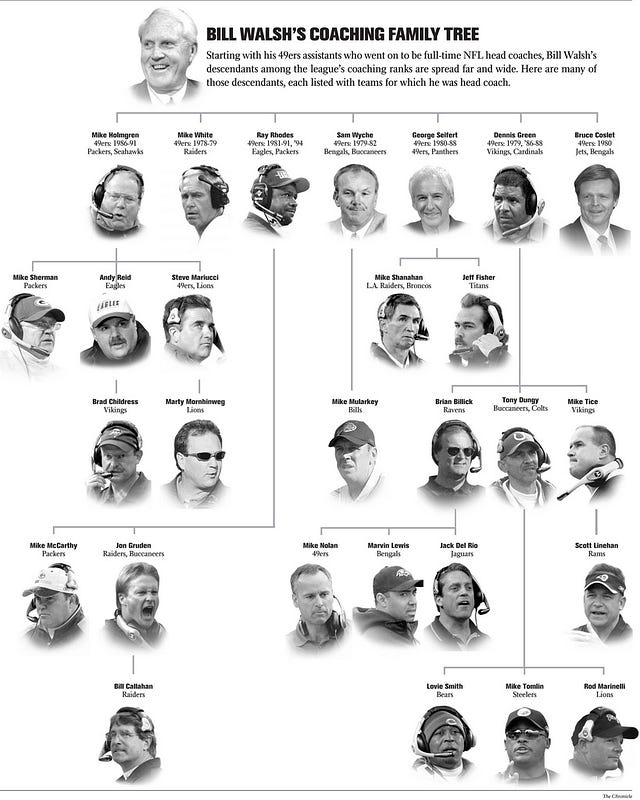At a time when people seem to be increasingly pushed aside as we race toward an uncertain future, each of these issues represents an essential component of contemporary mentoring. But it’s the first point that brought us here today.
 The coaching tree of Dr. James Naismith, the inventor of basketball
The coaching tree of Dr. James Naismith, the inventor of basketball
Any student of mentoring will recognize the name Fox Conner. His influence on the leaders of “The Greatest Generation” has been the subject of monographs, books, and countless articles. If you were to scribble Connor’s “mentoring tree” on the back of a napkin, it would probably look very similar to the “coaching tree” of Dr. James Naismith, whose influence on the sport of basketball is still visible today. Connor’s tree would likely feature the names of his early proteges, leaders such as George C. Marshall, Dwight D. Eisenhower, Omar Bradley, and George S. Patton. It would branch into subsequent generations and capture the incredible influence of a humble man whose subtle leadership defined how we view mentoring today.
 Former NFL and NCAA coach Bill Walsh influenced generations of coaches through his preparation and study of the game, and the development of the “West Coast Offense”
Former NFL and NCAA coach Bill Walsh influenced generations of coaches through his preparation and study of the game, and the development of the “West Coast Offense”
If we took the time to assemble mentoring trees for our most influential leaders, the outcome would surely capture the imagination. Imagine what we could learn about ourselves, our profession, and how we develop leaders. Even a cursory examination of legendary football coach Bill Walsh’s coaching tree reveals the influence of a special genius that fundamentally changed the sport, while leading to no fewer than ten Super Bowl champions in his wake. Long after his death, students of the game will still be debating his influence.
But what about the influence of “toxic” leaders?
If you want to talk about something that prove truly informative, a “toxic leader tree” might reveal more about our profession than we can imagine — or want to imagine, possibly. Are there causal relationships between weak leaders and the subsequent performance of their subordinates? How does a corrupt leader influence those around him? How does someone like formerBrigadier General Jeffrey Sinclair impact his command team? His subordinate commanders? His peers?
It’s a subject worth studying, a topic in need of further examination.
On a personal level, I learned as much from bad leaders as I did from the really good ones. Learning what not to do is at least as important as learning what “right” looks like. That doesn't mean I didn’t make mistakes along the way, but I took great care to learn from the mistakes of others as much as possible, rather than relearn those mistakes myself. But my exposure to toxic leaders through the years probably did more to shape my personal leadership style than anything else (and I've got the scar tissue to prove it).
If we really want to understand the long-term, multigenerational impact of leaders — both good and bad — then we need to be willing to explore some brutally honest methods of analysis. Mentoring trees would do much to reveal the positive influence of “phenomenal” leaders on our profession, but could also prove informative on how we manage and leverage talent at the highest levels. Toxic leader trees, on the other hand, could prove beneficial in understanding how negative leadership influences subsequent generations of leaders — something we don’t understand nearly as well as we should.
Does a leader who carries on an extra-marital affair inspire others to follow his example? Will a risk-averse leader produce subordinates unwilling to extend trust to their junior leaders? What about leaders with alcohol problems? Leaders who cheat on their physical fitness tests? Leaders who abuse their subordinates? If we hope to control and limit the influence of negative leadership, we first need to understand how it spreads, how it proliferates through the generations.
It’s time to be brutally honest with ourselves.
“You learn far more from negative leadership than from positive leadership. Because you learn how not to do it. And, therefore, you learn how to do it.” ~ Norman Schwarzkopf
No comments:
Post a Comment